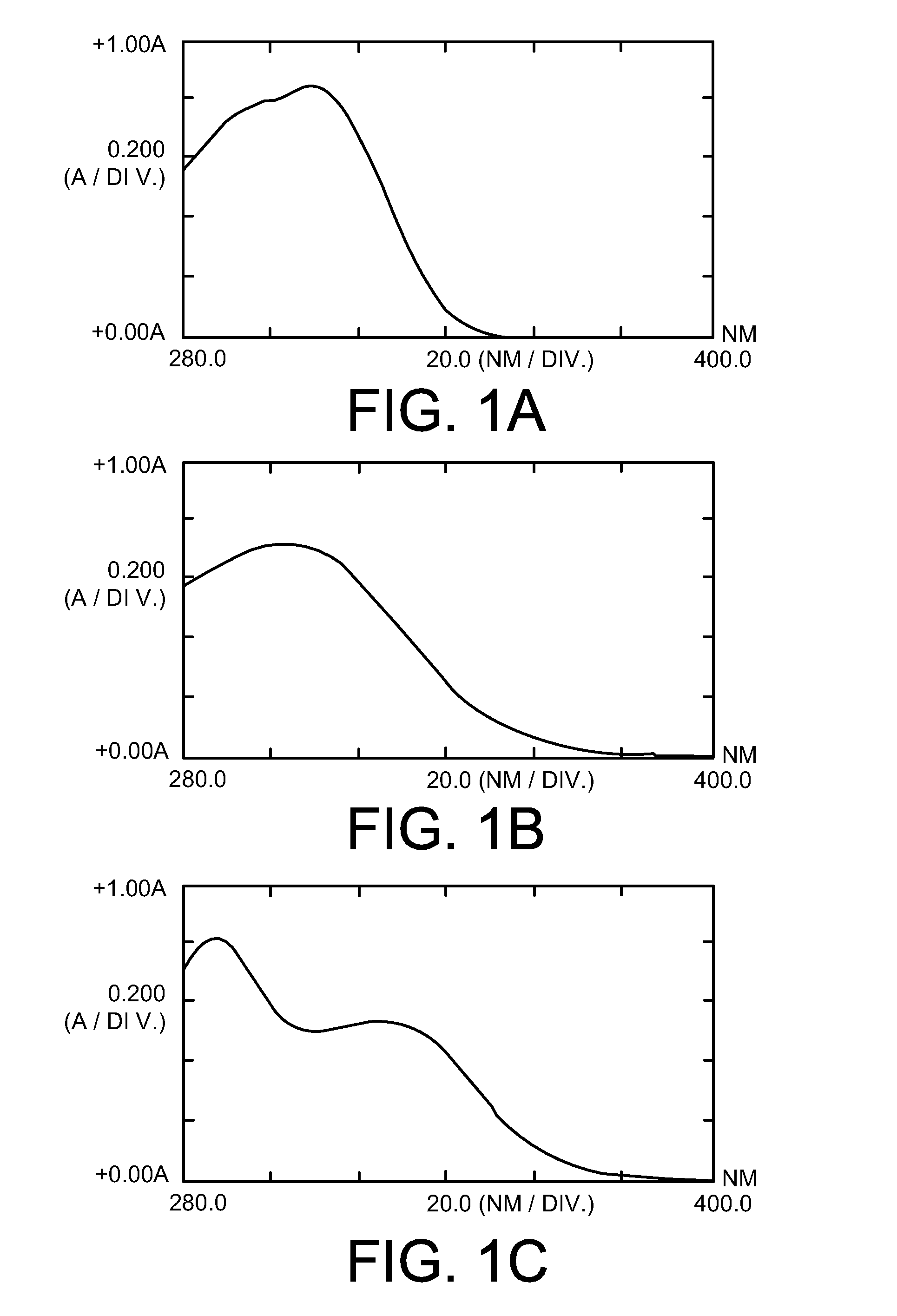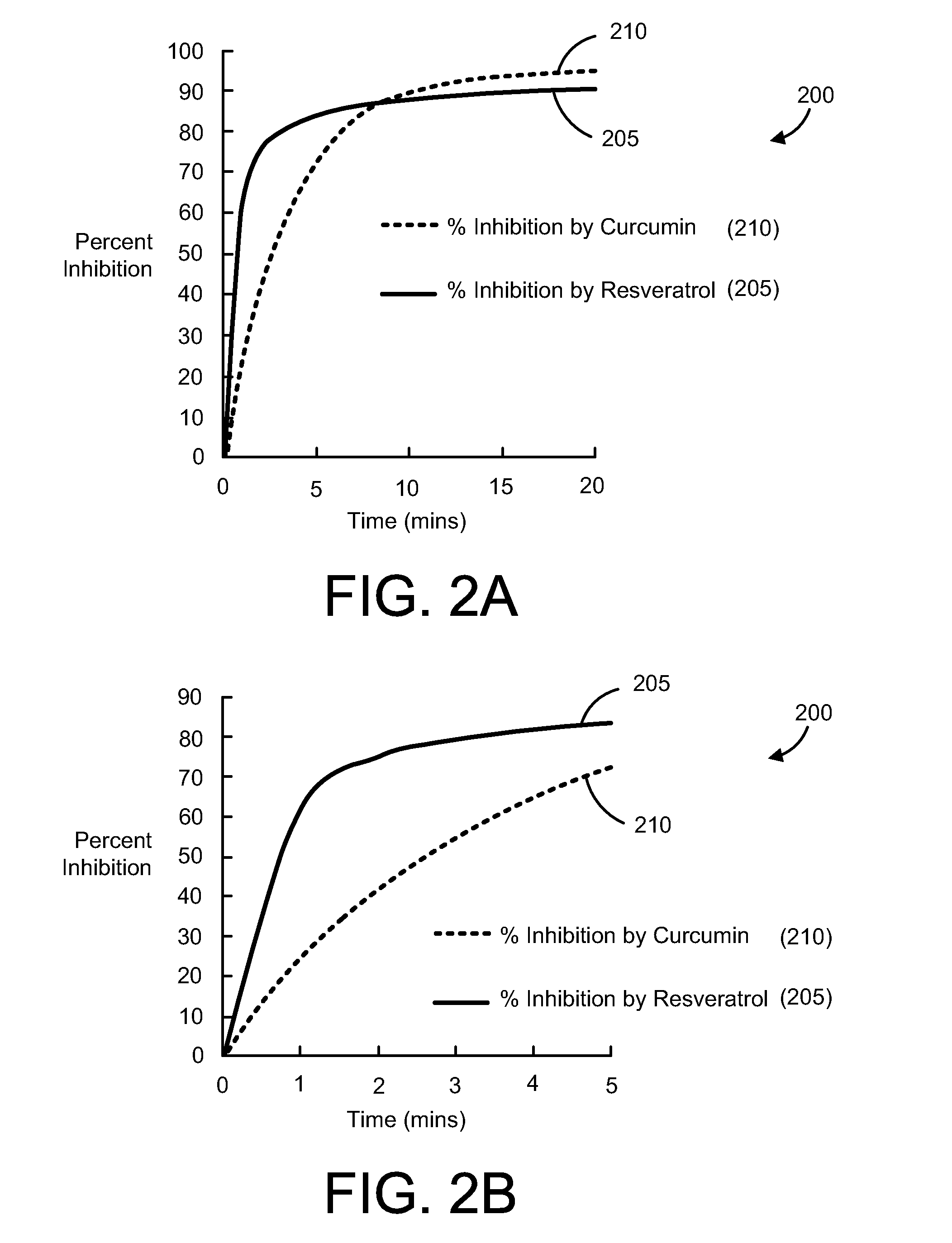Novel formulations and uses for curcuma extracts
a curcuma extract and formulation technology, applied in the field of curcuma extract formulations and uses, can solve the problems of inability to obtain the desired level of protection for consumers, fda, and the light absorption of sunscreen chemicals, and achieve the effect of enhancing the activity of compounds of interest and enhancing the activity of compounds
- Summary
- Abstract
- Description
- Claims
- Application Information
AI Technical Summary
Benefits of technology
Problems solved by technology
Method used
Image
Examples
example 1
Extracting Curcuma longa L. Root with Ethanol
[0096]A variety of solvents may be used to extract the Curcuma longa L. root, and this example shows how the extraction can be done using ethanol.
[0097]Preparing Fresh Curcuma longa Root for Extraction
[0098]The extraction can be done with fresh Curcuma longa root, and the root can be prepared as follows:
[0099]Material
Fresh Curcuma longa root50 g
[0100]Method[0101]1. Wash the fresh root in water to remove any traces of soil or other contaminants;[0102]2. Drain to remove excess water;[0103]3. Pat dry with paper towel;[0104]4. Using a sharp knife or scapel, cut the root into pieces approximately ½″×1 / 2″; and,[0105]5. Use the moist, freshly-cut root pieces for extraction.
[0106]Preparing Dried Curcuma longa Root for Extraction
[0107]The Curcuma longa L. root may have been dried, for example, for storage. The dried root can be prepared for extraction as follows:
[0108]Material
Dried Curcuma longa root30 g
[0109]Method[0110]1. Wash the dried root in ...
example 2
Extracting Curcuma longa L. Root with Sesame Oil
[0158]The extracts removed using oils that are at least substantially non-toxic, as discussed herein, can be considered as highly favorable to those in the art, as the extracts can be included directly into topical or oral formulations without the use of additional separation steps that include, for example, removal of the extract from the extraction solvent prior to making an at least substantially non-toxic formulation for use.
[0159]Material
Prepared Curcuma longa root50 g
[0160]Method[0161]1. Transfer the prepared Curcuma longa root to a 250 mL beaker;[0162]2. Pour sesame oil into the beaker until it covers the prepared material;[0163]3. Allow to macerate for 48 hours, with mixing after 24 hours;[0164]4. Decant the clear solvent;[0165]5. Add a second amount of sesame oil to cover the prepared Curcuma longa root in the beaker;[0166]6. Allow to macerate for a further 48 hours;[0167]7. Decant the clear solvent;[0168]8. Filter the remaini...
example 3
Assessing Extraction Efficiency of Different Solvent Systems
[0171]The extraction efficacy of different solvent systems were investigated for extraction of curcumin, deoxy curcumin, bis-deoxy curcumin and possibly other curcumin derivatives and related substances (collectively “curcuminoids” hereafter) from plants of the family Zingerberaceae, especially Curcuma longa L. While not intending to be bound by any theory or mechanism of action, it may be desired to utilize the whole extract, since plant components are believed to work together to modulate component activities. Biocompatible solvents were the focus, for at least the reasons set-forth herein, including the ability to use the extract in the liquid form (including the extraction solvent) directly in pharmaceutical formulations that are at least substantially non-toxic and acceptable for human use, topically or orally.
[0172]Material
[0173]Liquid paraffin (light and heavy), glycerin, sesame oil, ethanol, cotton seed oil, polyeth...
PUM
| Property | Measurement | Unit |
|---|---|---|
| wavelengths | aaaaa | aaaaa |
| wavelengths | aaaaa | aaaaa |
| wavelengths | aaaaa | aaaaa |
Abstract
Description
Claims
Application Information
 Login to View More
Login to View More - R&D
- Intellectual Property
- Life Sciences
- Materials
- Tech Scout
- Unparalleled Data Quality
- Higher Quality Content
- 60% Fewer Hallucinations
Browse by: Latest US Patents, China's latest patents, Technical Efficacy Thesaurus, Application Domain, Technology Topic, Popular Technical Reports.
© 2025 PatSnap. All rights reserved.Legal|Privacy policy|Modern Slavery Act Transparency Statement|Sitemap|About US| Contact US: help@patsnap.com



